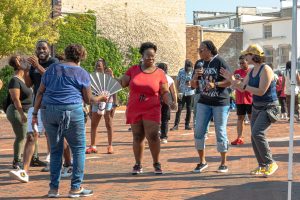Media must break black myths for kids’ sake
October 29, 1990
The Washington Post
William Raspberry
A man I know was driving his 11-year-old son home the other night when the youngster hit him with a question from out of the blue.
“Daddy,” he wondered, “do white people take drugs?”
Of course they do, my friend answered.
“Well,” said the boy, “I never hear anything about it.”
My friend didn’t know what to make of that brief conversation. I don’t either. But I’m afraid it stands as an indictment of the calling in which I earn my living: Journalism.
How could a bright young black child with the economic and intellectual advantages of a middle-class family reach the conclusion that drug abuse is the result of some peculiar character flaw of black people? The answer is that our reporting virtually forces the conclusion.
We know the drug-ridden inner-city neighborhoods represent the only public manifestation of a problem that permeates the society.
We are aware of the statistics indicating that perhaps 70 to 80 percent of the consumption of illicit drugs happens outside the ghettos.
We know that poor people haven’t enough money to sustain the international trafficking in drugs, or to turn it into an obscenely lucrative business.
But that knowledge rarely informs our stories and commentaries. Why?
I think there are two main reasons. The first is that white and middle-class drug abusers are far less more likely than their inner-city counterparts to come to the attention of the police and therefore, to the attention of the media.
Their drug deals and drug consumption are more likely to take place in private, with minimal risk of arrest.
There are few open-air drug markets in the white parts of town, few trials of white drug kingpins (or white money launderers or importers of illegal narcotics) and few beeper-equipped white kids walking the halls of our high schools.
The public problem of drugs is overwhelmingly an inner-city problem.
The second reason—the reason I have contributed to the false impression of my friend’s son—is that it is black neighborhoods that by far are most likely to be overwhelmed by drugs.
I write about drugs in the inner-cities because that is where we find the drug violence, the daily murders, the wrecked communities, the crack babies and the other manifestations of the appalling effects of the deadly drug traffic.
White people, though they may suffer the horror of drug abuse, tend to suffer individuals, and in private. Blacks suffer as entire communities, no matter that the overwhelming majority in the most-depressed ghettos never become involved with drugs.
But if that explains my frequent focus on drug abuse among blacks, I’m still dismayed by my contribution to the misperceptions of that 11-year-old boy—and no doubt, thousands like him.
Indeed it occurs to me that he might have asked a whole series of embarrassing questions based on what he learns from me and my fellow journalists.
Daddy, do people in the inner-cities ever do anything worthwhile? Do they love their children, care about their education, fear for their future, encourage their ambition?
Daddy, are all tutors and other volunteers white? Are there no superlative teachers in the schools in low-income neighborhoods?
Daddy, are there any white people on welfare? In jail? Guilty of abuse of office? Having children out of wedlock, or as teenage parents?
Daddy, what’s wrong with us?
I know that many of the social problems that occupy us are problems that are likely to be exacerbated by poverty and despair, and that blacks are the disproportionate victims of both poverty and dispair.
But the youngster’s question—and the questions he might have asked—should prompt us, both as parents and as journalists, to emphasize the connection of these problems to poverty rather than to race.
His innocent inquiry should lead us to a more-balanced investigation and discussion of what we already know. For instance, the No. 1 cash crop of both Kentucky and California is marijuana. Do we believe that producers and customers for these illicit crops are mostly inner-city blacks?
Do we believe that the bankers and other businessmen who launder the proceeds of the traffic in narcotics are residents of the black ghettos?
Do we believe that the billions of dollars made in the deadly traffic cocaine and heroine are enriching the black community?
We know better, but you couldn’t tell it from our news accounts. Don’t we owe it to that 11-year-old—and to all our children—to provide a more complete context in which they can think about the problems that beset the American society?
Daddy, what’s wrong with the media?






